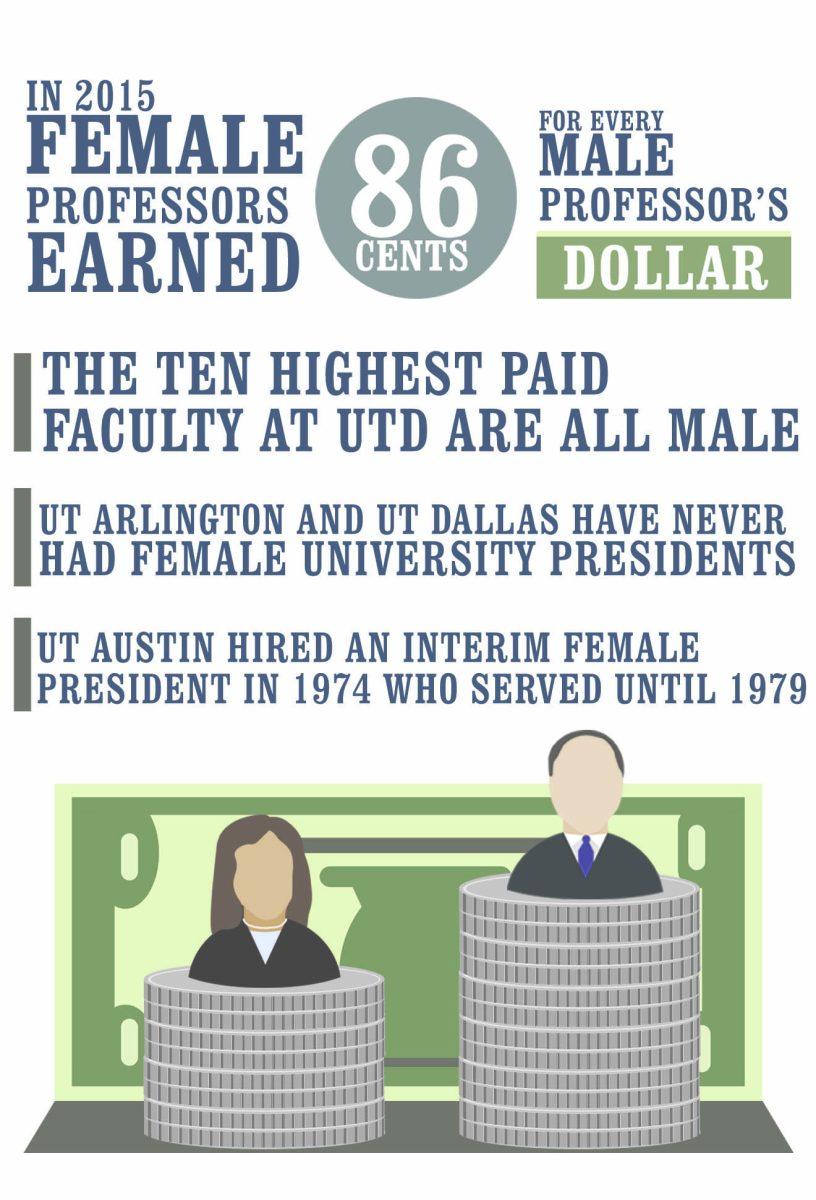UTD’s fall 2016 profile showed that female faculty members are outnumbered by men nearly two to one. While that gap is closing over time, the university’s gender wage gap is increasing and currently rests at two cents below the national average.
According to Chronicle Data, which compiles research from the Integrated Postsecondary Education Data System, female professors at UTD earned 86 cents to a male professor’s dollar in 2015, down from 97 cents in 2008. On the other hand, the same data shows that the average female professor at a four-year public college made 87.5 cents to her male counterpart’s dollar, placing UTD’s wage gap among professors above the national average.
Faculty hiring, promotion and tenure are some of the Provost’s responsibilities. Executive Vice President Hobson Wildenthal served as Provost from 1999 to 2015, when Inga Musselman took over.
“Once someone is hired in at a salary, there’s a tendency for it to only grow in an evolutionary fashion,” Wildenthal said. “So the real problem is when you hire people in at the wrong salaries. It’s not easy to change, but we do try to correct that over time.”
The provost, along with the deans of each school, performs an annual salary review to prevent unfair compensation among faculty. If inequities are found, a portion of the raise pool is used to equalize pay. Despite this approach, IPEDS data shows that the top 10 highest earning faculty members at UTD are all male.
“In science, engineering and management, there’s a significant preponderance of males over females, and that’s a concern here and elsewhere,” Wildenthal said. “We want to be sure we’re doing at least as well as other institutions.”
Female endowed chairs are outnumbered by men in every UTD school, including Engineering and Computer Science, which has 28 male endowed chairs compared to four females. This gender gap translates to a wage gap like the school of Economic, Political and Policy Sciences, where IPEDS data shows that the highest paid male endowed chair makes over $100,000 more annually than his highest paid female counterpart.
Director of Human Resources Colleen Dutton handles employee relations and provides training for hiring managers. Dutton, who investigates concerns about pay based on an employee’s position, said numerous factors are involved in salary negotiations.
“We look at their education, their experience, their length of service, annual reviews and their different skill sets and how difficult is it to fill that position,” Dutton said. “So it’s not just about the pay, but there are a lot of different factors that go into determining what appropriate pay is.”
The wage gap for full professors at other UT schools, such as the University of Texas at Austin, is below the national average, with female professors making 92 cents to their male counterpart’s dollar. The University of Texas at Arlington’s professors have nearly equal pay, with female professors making 99.7 cents to their male counterpart’s dollar.
Sociology professor Sheryl Skaggs said this gap may be due to opportunity hoarding, which theorizes that employees in high ranking positions often hire people that are similar to them, a process that may occur consciously or subconsciously. UT Arlington and UTD have never had female university presidents while UT Austin had an interim female president who served from 1974 to 1979. According to the Boston Globe, women made up 26 percent of all college presidents in 2011, despite earning more doctoral degrees than men since 2006.
“People that are doing the hiring don’t recognize the subtle biases or the biases that they have built into the process or in their own minds using stereotypes to define who would fill particular positions and what salary they think those positions should be filled at,” Skaggs said.
Director of Institutional Equity Heather Dragoo said UTD’s employment searches for full-time tenured faculty members are handled through the provost’s office by a faculty search committee. The committees consist of the dean of the respective school, as well as several faculty members appointed by the dean. These committees meet with Dragoo after hiring cycles to discuss where the job search was advertised, who ended up filling the position and where the department is lacking in terms of diversity.
“That’s been going on for about two years now, and it’s been pretty productive,” Dragoo said. “This is not something that’s going to change overnight, it’s going to be small, hire-by-hire … but all of the faculty groups I’ve met with have been really receptive.”
Skaggs said the problem also resides in online compliance training, which is less effective than face-to-face programs and doesn’t guarantee the attentiveness of participants. Dragoo said online programs don’t allow trainees to ask questions, but in-person training is provided at new employee orientations, which occur every other Tuesday. Additionally, the department plans to create a new position to help cover in-person training, but the filling of that position was put on hold while the office searches for candidates for another staff position.
Dutton said she receives complaints about unequal pay from employees about two to three times per year, mostly from faculty members, while Dragoo receives one to two annual faculty complaints concerning discrimination. Both said a majority of the complaints received are from female employees. Skaggs said shifting to more transparent hiring processes and salary data can help female workers in the long run.
“Moving toward transparency is going to help women in a lot of ways,” Skaggs said. “It gives them access to the same salary information that their male competitors in the job market are getting.”
Several organizations, including the Dallas Women’s Foundation, are taking a stand for equal pay. Dena Jackson worked at the Galerstein Gender Center from 2006 to 2011 before becoming vice president of grants and research at the Dallas Women’s Foundation, an organization geared toward gaining equality for girls and women. She explained that women are more likely to take time out of the workforce and are overrepresented in lower paying fields while being underrepresented in higher paying fields like STEM.
“Women often receive lower paying starting salaries, which compounds over time,” Jackson said. “To say that women choose positions that pay less does not take into account the societal and cultural pressures on education and career choices.”
The budget office is in charge of finding sources of funding to pay staff salaries, which can cost between $2.2 to $2.5 million annually. Vice President of Budget and Finance Terry Pankratz explained that UTD recruits faculty from upper tier universities, so there’s an enormous amount of competition. However, Skaggs said the lack of job interest from women and minorities may be due to public perceptions of UTD.
“Academia is a pretty small world,” Skaggs said. “If we bring women in, but we don’t give them the same resources, we don’t give them the same budgets, we don’t give them the same graduate students and other types of support systems that we give our male faculty members with the same kind of qualifications, then that’s sending a very bad message into the world of academia.”
Looking toward the future, Skaggs recommends more diverse hiring committees and less traditional methods of outreach, such as networking through national conferences, to widen the applicant pool. According to the Institute for Women’s Policy Research, national wage equality between genders won’t occur until 2058, but the pay gap in Texas is set to close before then in 2049. Skaggs said while these trends are positive, there’s still work to be done in order for women to have pay equality.
“Just saying there’s societal pressure for change, or a push toward equity is not sufficient,” Skaggs said. “I think it’s going to take a much stronger force to get these longstanding institutions to change the culture and the way they think about equity.”

















